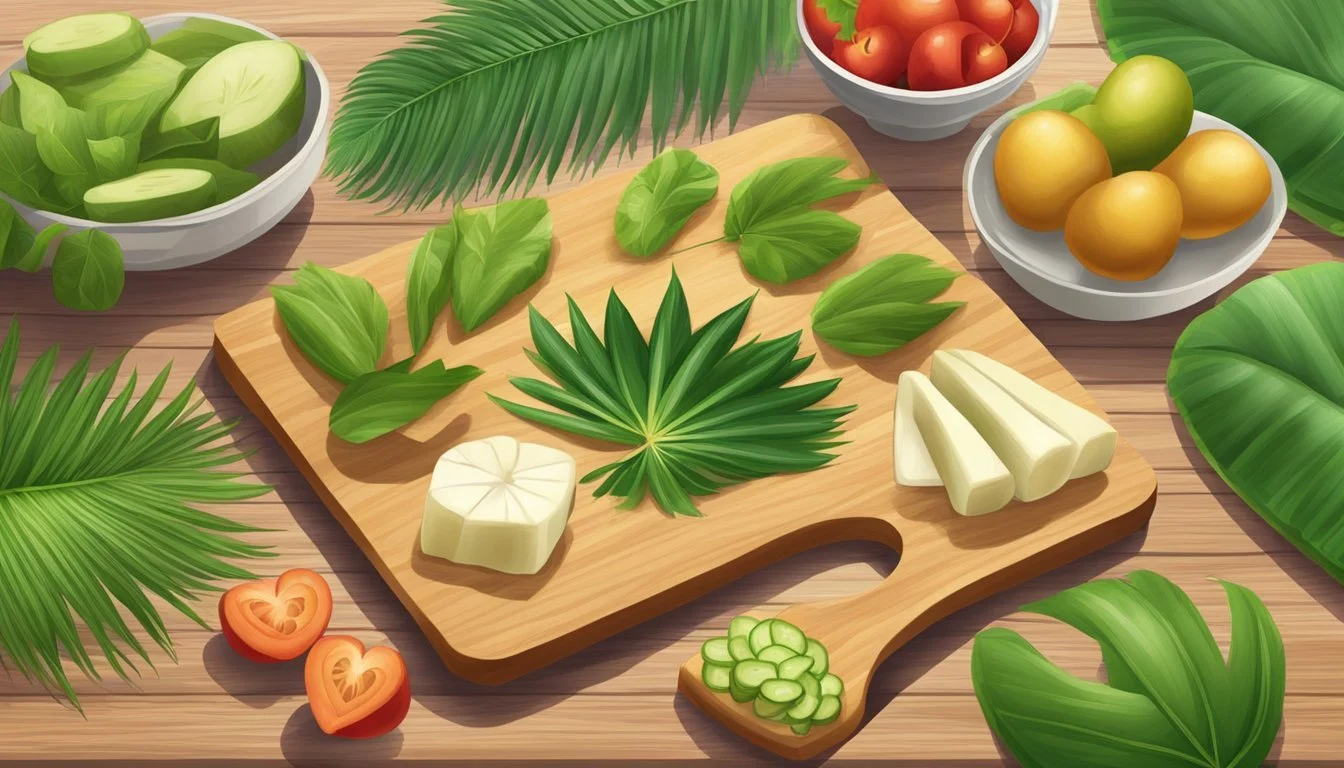Hearts of Palm Substitutes
Top Alternatives for Your Recipes
Finding a substitute for hearts of palm can be essential when they are not readily available or when a healthier option is desired. Hearts of palm, harvested from the inner part of certain palm trees, offer a unique texture and flavor, often used in salads, pasta, and various dishes.
One excellent alternative to hearts of palm is cactus pads, also known as nopales. These robust pads share a similar texture and taste, making them an adaptable swap in many recipes. Additionally, they are more accessible and cost-effective, offering nutritional benefits with their high fiber and vitamin content.
Another viable substitute is artichoke hearts. Both hearts of palm and artichoke hearts have closely related flavors and can be interchanged in dishes like sauces and gravies. Using these substitutes can help maintain the distinct taste and texture that hearts of palm bring to culinary creations, ensuring your recipes remain delicious and satisfying.
Understanding Hearts of Palm
Hearts of palm are the tender inner core of certain palm tree varieties. They are prized for their soft, delicate texture and mild flavor, which make them a versatile ingredient in many culinary applications. Additionally, they offer several nutritional benefits, contributing to digestive and heart health.
Origins and Characteristics
Hearts of palm are harvested from the inner core of specific palm trees, such as peach palms and açai palms. This process involves removing the tough outer layers to expose the tender heart inside. They have a pale ivory color and a firm, yet tender texture.
They often resemble white asparagus in appearance. Harvesting hearts of palm is labor-intensive and has raised sustainability concerns, although cultivation practices have improved to mitigate these impacts.
Culinary Uses
Hearts of palm have a mild, slightly nutty flavor and can be used in various dishes. They are popular in salads, adding a crunchy texture reminiscent of artichokes. They can also be sliced and incorporated into stir-fries, dips, and pasta dishes.
Recently, they have gained popularity as a substitute for traditional noodles, offering a low-calorie, gluten-free alternative. To achieve the desired texture, they can be boiled or sautéed briefly.
Nutritional Info
Hearts of palm are low in calories and have a noteworthy nutrient profile. A typical 100-gram serving contains approximately:
20 calories
0g fat
5g carbohydrates
3g fiber
2g sugar
1g protein
They are also a good source of essential vitamins and minerals, including potassium and vitamin C. The fiber content supports digestive health, while the low-calorie and low-fat content make them heart-friendly. Including hearts of palm in a balanced diet can contribute to overall wellness.
Common Reasons for Substituting Hearts of Palm
Availability, cost considerations, and dietary restrictions are some of the main factors that prompt consumers to look for substitutes for hearts of palm.
Availability
Hearts of palm can sometimes be difficult to find in stores, particularly in regions where they are not a common ingredient. This can make recipes that call for them challenging to prepare.
Consumers may need to look for alternatives that are more readily available in their local grocery stores. Common substitutes include cactus pads, eggplant, and bamboo shoots, all of which can be found in most well-stocked supermarkets.
Cost Considerations
Hearts of palm can be relatively expensive compared to more common vegetables. This cost factor might deter some home cooks from using them frequently.
Substitutes like mushrooms and Brussels sprouts offer a more budget-friendly option without sacrificing the taste and texture that hearts of palm bring to dishes. Economically, switching to these alternatives makes it possible to enjoy similar flavors and nutrition profiles while keeping grocery bills in check.
Dietary Restrictions
Dietary needs may also necessitate finding substitutes for hearts of palm. Some individuals look for ingredients that offer similar nutritional values such as high fiber and vitamins but align better with their dietary restrictions.
Options like cactus pads provide a good source of fiber and vitamins, making them appealing to those focused on nutritional benefits while avoiding specific allergens or ingredients they can't consume. Substitutes must meet dietary requirements without compromising the desired outcome of the dish.
Ideal Substitutes for Hearts of Palm
For those seeking alternatives to hearts of palm, several options offer similar textures and flavors. Each substitute brings its unique qualities, making them suitable for various culinary applications.
Artichoke Hearts
Artichoke hearts are a popular substitute for hearts of palm. They share a similar mild flavor and tender texture. Artichoke hearts can be used in salads, dips, or even cooked dishes.
These hearts are rich in antioxidants which contribute to their health benefits. Artichoke hearts are widely available, canned, or marinated, making them an accessible option. The versatility of artichoke hearts allows them to be incorporated into numerous recipes with ease.
Jerusalem Artichokes
Jerusalem artichokes, also known as sunchokes, offer another viable alternative. They have a slightly nutty flavor and crunchy texture when raw, which softens when cooked.
These tubers are high in fiber, adding nutritional value to dishes. Jerusalem artichokes can be roasted, sautéed, or included in purees. Their unique flavor profile complements many dishes, providing an interesting twist to traditional recipes using hearts of palm.
Bamboo Shoots
Bamboo shoots are another excellent replacement, particularly in Asian cuisine. They have a crisp texture and a mild, subtly sweet flavor.
Available canned, fresh, or pickled, bamboo shoots are versatile. They are often used in stir-fries, soups, and salads. Bamboo shoots are also low in calories and high in fiber, making them a healthy addition to meals. Their crunchy consistency offers a pleasant contrast in dishes that call for hearts of palm.
Vegetable Alternatives
Vegetable alternatives to hearts of palm include various cabbage varieties, stalky vegetables, and root vegetables. Each option offers unique textures and flavors that can seamlessly replace hearts of palm in numerous dishes.
Cabbage Varieties
Kohlrabi, cabbage, and Brussels sprouts provide versatile substitutions. Kohlrabi has a crisp texture and a mildly sweet flavor, making it an excellent alternative in salads and stir-fries. Cabbage can be shredded or chopped to mimic the tender consistency of hearts of palm in slaws or wraps. Brussels sprouts offer a dense, slightly nutty taste and work well in roasted or steamed dishes. Their leaves can also be separated and cooked to achieve a texture similar to hearts of palm.
Stalky Vegetables
Stalky vegetables like broccoli, celery, and cardone serve as robust replacements. Broccoli stalks, often overlooked, can be peeled and sliced to match the slight crunch of hearts of palm in stews and casseroles. Celery brings a refreshing, crunchy texture ideal for soups and salads, while cardone—related to artichokes—offers a similar texture and can be used in gratins or baked dishes. These vegetables are also nutrient-rich, providing vitamins and fiber beneficial for a balanced diet.
Root Vegetables
Root vegetables such as chayote and jicama are substantial alternatives. Chayote has a mild flavor and a smooth, crisp texture similar to hearts of palm. It can be sliced or diced in salads and stir-fried dishes. Jicama, known for its juicy, slightly sweet profile, is perfect for adding a crunch to salads and slaws. Both vegetables are hydrating and low in calories, making them healthy swaps. They are versatile and can retain their texture well in a variety of cooking methods.
Using Legumes and Fruits as Substitutes
Legumes and fruits can serve as excellent alternatives to hearts of palm, providing unique textures and flavors. These substitutes often offer additional nutritional benefits and can enhance a variety of dishes.
Okra and Zucchini
Okra and zucchini are versatile vegetables that can mimic the texture of hearts of palm in many recipes.
Okra's slightly mucilaginous texture makes it a good thickening agent in stews and soups. It has a mild flavor that absorbs the seasonings it's cooked with, making it a flexible choice for different cuisines.
Zucchini, on the other hand, has a firm yet tender consistency. When sliced into rounds or strips, zucchini can stand in for hearts of palm in salads or grilled dishes. Its neutral flavor allows it to adapt well to both savory and slightly sweet preparations.
Olives
Olives can replace hearts of palm in dishes where a stronger flavor is desired. Green and black olives bring a distinct briny taste that can elevate recipes.
Green olives are typically firmer and have a tangy, slightly bitter taste. They can be finely chopped and added to salads, pasta dishes, or even as a pizza topping to add a burst of flavor.
Black olives are usually softer and have a milder, saltier flavor. They pair well with Mediterranean dishes and can be used whole, sliced, or chopped as a replacement for hearts of palm in various recipes.
Preparation and Cooking Tips
When preparing hearts of palm or their substitutes, techniques vary depending on the type of dish you are making. Here are some useful methods for maximizing flavor and texture across various recipes.
Salads and Dips
For salads, hearts of palm should be thinly sliced or chopped. This ensures they blend well with other ingredients without overpowering them.
Tip: Combine with vinaigrettes or citrus-based dressings to enhance their natural flavor.
In dips, hearts of palm or their substitutes like cactus pads can be blended smoothly to add a creamy texture. They pair particularly well with herbs like dill and cilantro.
Example Recipe:
Hearts of Palm Dip – Blend hearts of palm with Greek yogurt, garlic, lemon juice, and fresh herbs until smooth. Serve with pita chips or vegetable sticks.
Soups and Braised Dishes
In soups, hearts of palm and substitutes like bamboo shoots or artichoke hearts absorb the flavors of the broth. Add them in the last 5-10 minutes of cooking to retain their firmness.
Tip: Incorporate them into clear broths or creamy bisques for a subtle yet distinct flavor addition.
For braised dishes, cook hearts of palm with other vegetables and proteins. Their texture holds up well to slow cooking.
Braised Recipe Idea: Combine hearts of palm with fennel, tomatoes, and white wine. Simmer until all ingredients are tender and flavors meld together.
Roasted and Grilled Recipes
Roasting hearts of palm or alternatives like zucchini offers a caramelized, savory flavor. Slice into even pieces, toss with olive oil, salt, and pepper, then roast at 400°F for about 20 minutes.
Tip: Pair with robust herbs like rosemary or thyme for added depth.
Grilling brings out a smoky flavor. Marinate hearts of palm or substitutes such as eggplant in a mix of olive oil, lemon juice, and garlic. Grill on medium heat until slightly charred and tender.
Simple Grilled Dish: Skewer slices of hearts of palm, brush with marinade, and grill for 5-7 minutes on each side.
Food Handling and Storage
Proper handling and storage of hearts of palm are crucial to maintaining their freshness, quality, and safety. The following guidelines provide essential information on shelf life and optimal storage conditions.
Freshness and Shelf Life
Hearts of palm, whether fresh or canned, have specific shelf life durations. Fresh hearts of palm typically last up to two weeks when stored under ideal conditions. Canned varieties, with proper sealing and no damage to the packaging, can last for up to two years.
Important Factors Affecting Freshness:
Temperature: Keeping hearts of palm refrigerated between 32°F and 40°F helps prolong their freshness.
Airflow and Humidity: Good air circulation and low humidity can prevent spoilage and mold growth.
Packaging: Properly sealed containers or vacuum-sealed bags protect against moisture and air exposure.
Proper Storage Conditions
For fresh hearts of palm, refrigeration is essential. Store them in the crisper drawer to maintain appropriate humidity levels. It’s advisable to separate them from ethylene-producing fruits like apples and bananas, as ethylene can accelerate spoilage.
For canned hearts of palm, store them in a cool, dry place away from direct sunlight. Once opened, any unused portions should be placed in an airtight container and refrigerated. They should be consumed within three to five days for best quality.
Key Storage Tips:
Refrigerate fresh hearts of palm immediately after purchasing.
Keep storage areas clean and free of pests.
Monitor expiration dates on canned products to ensure safety and quality.
Adhering to these guidelines will ensure the hearts of palm remain fresh, delicious, and safe to eat.
Creative Uses Beyond Substitution
Hearts of palm offer versatile culinary potential that extends far beyond mere substitution in recipes. Their unique texture and subtle flavor can be creatively harnessed in delightful ways.
Innovative Dishes With Artichokes
Artichokes can be reimagined in unique ways to create memorable dishes. For instance, they can be blended into creamy dips that serve as excellent appetizers. When canned artichokes are used, they bring a convenient, ready-to-use element perfect for impromptu gatherings.
Another exciting preparation is artichoke-based pizza toppings. Thin slices of artichokes can transform a simple pizza into a gourmet experience with minimal effort. This approach works well with various substitutes for artichoke hearts, such as hearts of palm and cauliflower, which contribute to a rich, satisfying flavor profile.
Expanding the Use of Vegetables
Exploring the potential of vegetables beyond traditional methods can lead to surprising culinary discoveries. Incorporating hearts of palm in unusual applications, like in cold salads or even grilled, adds a new dimension to familiar recipes. They integrate seamlessly into dishes previously dominated by vegetables like artichokes.
Cauliflower also serves as a versatile ingredient, demonstrating its adaptability in everything from pizza crusts to rice alternatives. Such innovations can elevate standard meals, offering healthier and equally tasty variations. Hearts of palm, with their tender texture, can replace more calorie-dense options, making them a valuable addition to the kitchen.






